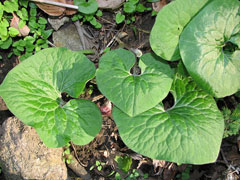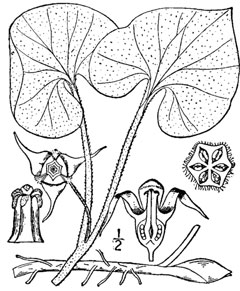 |
|
http://commons.wikimedia.org/wiki/User:Earthdirt Chris S. Packard |
 |
| USDA-NRCS PLANTS Database / Britton, N.L., and A. Brown. 1913. An illustrated flora of the northern United States, Canada and the British Possessions. Vol. 1: 642. |
Translate this page:
Summary
Bloom Color: Brown, Purple.
Main Bloom Time: Early spring, Mid spring. Form: Spreading or horizontal.
Physical Characteristics

 Asarum canadense is a deciduous Perennial growing to 0.1 m (0ft 4in) by 0.5 m (1ft 8in) at a slow rate.
Asarum canadense is a deciduous Perennial growing to 0.1 m (0ft 4in) by 0.5 m (1ft 8in) at a slow rate.
See above for USDA hardiness. It is hardy to UK zone 2. It is in flower in May. The species is hermaphrodite (has both male and female organs) and is pollinated by Flies.
Suitable for: light (sandy), medium (loamy) and heavy (clay) soils and prefers well-drained soil. Suitable pH: mildly acid, neutral and basic (mildly alkaline) soils. It can grow in full shade (deep woodland) or semi-shade (light woodland). It prefers moist soil.
UK Hardiness Map
US Hardiness Map
Synonyms
Plant Habitats
Woodland Garden Dappled Shade; Shady Edge; not Deep Shade; Ground Cover;
Edible Uses
Edible Parts:
Edible Uses: Condiment
The underground stem and the flowers are used as a ginger substitute[2, 55, 106, 177, 183]. The root, especially when quite dry, has a pungent, aromatic smell like mild pepper and ginger mixed, but more strongly aromatic[245]. The root is best harvested in autumn but is available all year round[159]. It can be dried for later use[159].
References More on Edible Uses
Medicinal Uses
Plants For A Future can not take any responsibility for any adverse effects from the use of plants. Always seek advice from a professional before using a plant medicinally.
Anthelmintic Antiasthmatic Antibiotic Antitumor Carminative Contraceptive Diaphoretic Diuretic
Expectorant Irritant Poultice Salve Stimulant Stomachic Tonic
Snake root was widely employed as a medicinal herb by a number of native North American tribes who used it to treat a wide range of ailments[257]. It is still occasionally used in modern herbalism. The root is anthelmintic, carminative, diaphoretic, diuretic, expectorant, irritant, powerfully stimulant, stomachic and tonic[4, 21, 46, 200, 238, 257]. It is harvested in the autumn and dried for later use[4]. It is used in the treatment of chronic chest complaints, asthma, coughs, colds, dropsy, painful spasms of the bowels and stomach, scant or painful menstruation, infantile convulsions[4, 257]. The fresh leaves are applied as a poultice to wounds and inflammations, whilst a decoction or salve is applied to sores[257]. The root contains antibiotic substances effective against broad-spectrum bacteria and fungi[207]. It also contains aristolochic acid, which has antitumor activity[222]. The root and rhizome were slowly boiled in a small quantity of water for a long time and the resulting liquid drunk as a contraceptive by the women of one N. American Indian tribe[213].
References More on Medicinal Uses
The Bookshop: Edible Plant Books
Our Latest books on Perennial Plants For Food Forests and Permaculture Gardens in paperback or digital formats.

Edible Tropical Plants
Food Forest Plants for Hotter Conditions: 250+ Plants For Tropical Food Forests & Permaculture Gardens.
More

Edible Temperate Plants
Plants for Your Food Forest: 500 Plants for Temperate Food Forests & Permaculture Gardens.
More

More Books
PFAF have eight books available in paperback and digital formats. Browse the shop for more information.
Shop Now
Other Uses
Incense
The slightly roasted root can be ground into a powder and then sprinkled onto clothing for perfume[257]. A useful ground cover for a shady position so long as it is not dry[197], spreading by its roots[208].
Special Uses
Food Forest Ground cover Scented Plants
References More on Other Uses
Cultivation details
Landscape Uses:Ground cover, Massing, Rock garden, Woodland garden. Prefers a rich moist neutral to acid soil in woodland or a shady position in the rock garden[1, 200]. Plants are found on alkaline soils in the wild[43]. Plants are hardy to at least -25°c[200]. The flowers are malodorous and are pollinated by flies[200]. Plants often self-sow when growing in a suitable position[200]. Special Features:Attractive foliage, North American native, Naturalizing, Inconspicuous flowers or blooms. The plant is heat tolerant in zones 8 through 1. (Plant Hardiness Zones show how well plants withstand cold winter temperatures.
Plant Heat Zones show when plants would start suffering from the heat.
The Plant Heat Zone map is based on the number of "heat days" experienced in a given area where the temperature climbs to over 86 degrees F (30°C).
At this temperature, many plants begin to suffer physiological damage. Heat Zones range from 1 (no heat days) to 12 (210 or more heat days).
For example Heat Zone. 11-1 indicates that the plant is heat tolerant in zones 11 through 1.) For polyculture design as well as the above-ground architecture (form - tree, shrub etc. and size shown above) information on the habit and root pattern is also useful and given here if available. The plant growth habit is a runner spreading indefinitely by rhizomes or stolons [1-2]. The root pattern is rhizomatous with underground stems sending roots and shoots along their length [1-2].
References Carbon Farming Information and Carbon Sequestration Information
Temperature Converter
Type a value in the Celsius field to convert the value to Fahrenheit:
Fahrenheit:
The PFAF Bookshop
Plants For A Future have a number of books available in paperback and digital form. Book titles include Edible Plants, Edible Perennials, Edible Trees,Edible Shrubs, Woodland Gardening, and Temperate Food Forest Plants. Our new book is Food Forest Plants For Hotter Conditions (Tropical and Sub-Tropical).
Shop Now
Plant Propagation
Seed - best sown in a cold frame as soon as it is ripe in the summer[134]. Stored seed will require 3 weeks cold stratification and should be sown in late winter[134]. The seed usually germinates in the spring in 1 - 4 or more weeks at 18°c[134]. When large enough to handle, prick the seedlings out into individual pots and grow them on in light shade in the greenhouse for at least their first winter. Plant them out when large enough in late spring. Division in spring or autumn. Plants are slow to increase[200]. It is best to pot the divisions up and keep them in light shade in the greenhouse until they are growing away strongly.
Other Names
If available other names are mentioned here
Native Range
NORTHERN AMERICA: Canada, Québec, Ontario, New Brunswick, Manitoba (southeast), United States, Connecticut, Indiana, Maine, Massachusetts, Michigan, New Hampshire, New Jersey, New York, Ohio, Pennsylvania, Rhode Island, Vermont, West Virginia, Illinois, Iowa, Kansas, Minnesota, Missouri, Nebraska (east), North Dakota (east), Oklahoma (northeast), South Dakota (east), Wisconsin, Alabama, Arkansas, Delaware, Georgia, Kentucky, Louisiana, Maryland, Mississippi, North Carolina, South Carolina, Tennessee, Virginia,
Weed Potential
Right plant wrong place. We are currently updating this section.
Please note that a plant may be invasive in one area but may not in your area so it's worth checking.
Conservation Status
IUCN Red List of Threatened Plants Status :

Growth: S = slow M = medium F = fast. Soil: L = light (sandy) M = medium H = heavy (clay). pH: A = acid N = neutral B = basic (alkaline). Shade: F = full shade S = semi-shade N = no shade. Moisture: D = dry M = Moist We = wet Wa = water.
Now available:
Food Forest Plants for Mediterranean Conditions
350+ Perennial Plants For Mediterranean and Drier Food Forests and Permaculture Gardens.
[Paperback and eBook]
This is the third in Plants For A Future's series of plant guides for food forests tailored to
specific climate zones. Following volumes on temperate and tropical ecosystems, this book focuses
on species suited to Mediterranean conditions—regions with hot, dry summers and cool, wet winters,
often facing the added challenge of climate change.
Read More
Expert comment
Author
L.
Botanical References
43200270
Links / References
For a list of references used on this page please go here
Readers comment